In board game taxonomy there are generally four domains: Abstract, American, Euro, and War. And while these definitions are fuzzy at best, they are fairly good at helping players understand their personal taste. Then there is Adrenaline, a game of high-energy player interaction, lengthy calculating turns, and almost no random elements. A constant need for strategy and planning wrapped in a theme of killing your opponents with mega violence.
Like I said—fuzzy at best.
A loving homage to 3rd-person-shooter video games, Adrenaline gives you a laser-tag arena and dozens of uniquely powerful weapons. Your goal is to spread bullety death without remorse, awarding you points whenever an opponent falls.
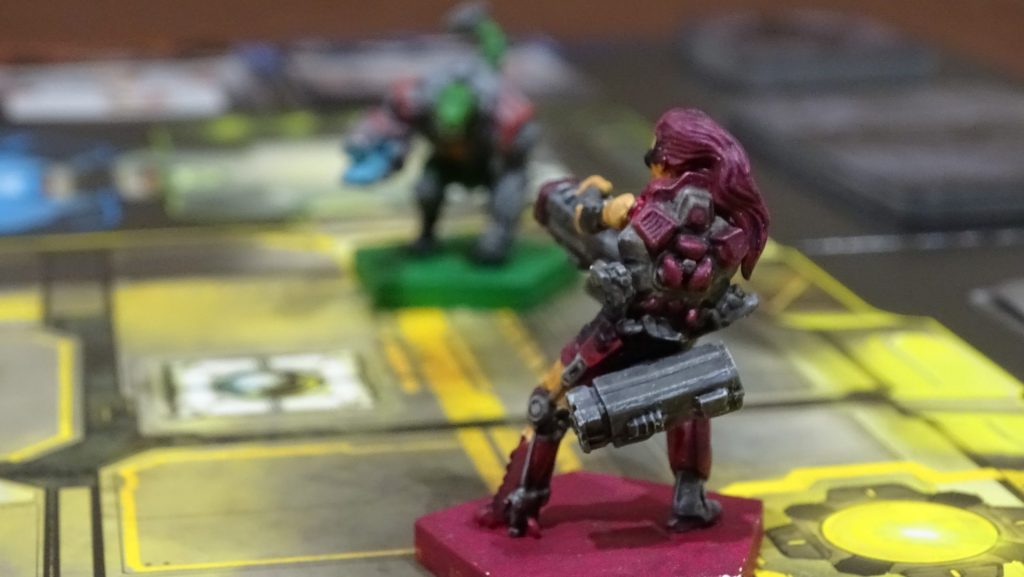
But don’t worry, this isn’t a single elimination game. Each death leads to respawn, allowing you to get right back to painting the walls. You suffer no penalty outside of a reposition; and you’ll be worth less points the next time you kiss the grim reaper.
Oh, and did I mention there are no dice?
Pure Strategy, Simple Elegance
This isn’t a farming simulator set in the Renaissance era, but Adrenaline is a Euro game at its core. Your shots always hit and almost all information is available at the start. You can treat it as a slow, paralyzing strategy game; or you can run around kicking ass and chewing bubblegum.
Each turn you’ll choose two actions among moving, shooting, and grabbing. Moving is fairly straightforward (but also left and right), and grabbing will let you pick up ammo or new weapons. There is a plentiful amount of each, allowing you to customize your style however you see fit.

Shooting involves none of the randomness you’d expect from this theme. You simply play a weapon card and do what it says. While most games of this style would have you roll dice to see how good a shot you made, the weapon cards in Adrenaline always perform at optimal efficiency—you do exactly what they say, allowing you to fully plan out your turn and prepare for future actions. At the end of your turn, you can pay the ammo reload cost of a used weapon to put it back in your hand ready for use next turn. No risks, only destruction.
Adrenaline also supports one of the cleanest line-of-sight rules I’ve used. It all works thematically, letting you imagine your figure being able to see the enemy. You can see anyone in the same room as you and any room you can see into from the doorway; but enemies deep in the adjacent room can’t see you because you’re hiding behind the corner of the door. Theme supporting mechanics—the hallmark of good design.
So, You’ve Been Shot…
That’s a good thing! Your death will award the enemy, so Adrenaline rewards your grit. As you take more damage your three basic actions improve, giving you a slight—but desirable—advantage. And when you do temporarily die, your point value drops, making you a less lucrative target. This prevents griefing; stronger players are encouraged to seek out other targets rather than continually stomp on one player.
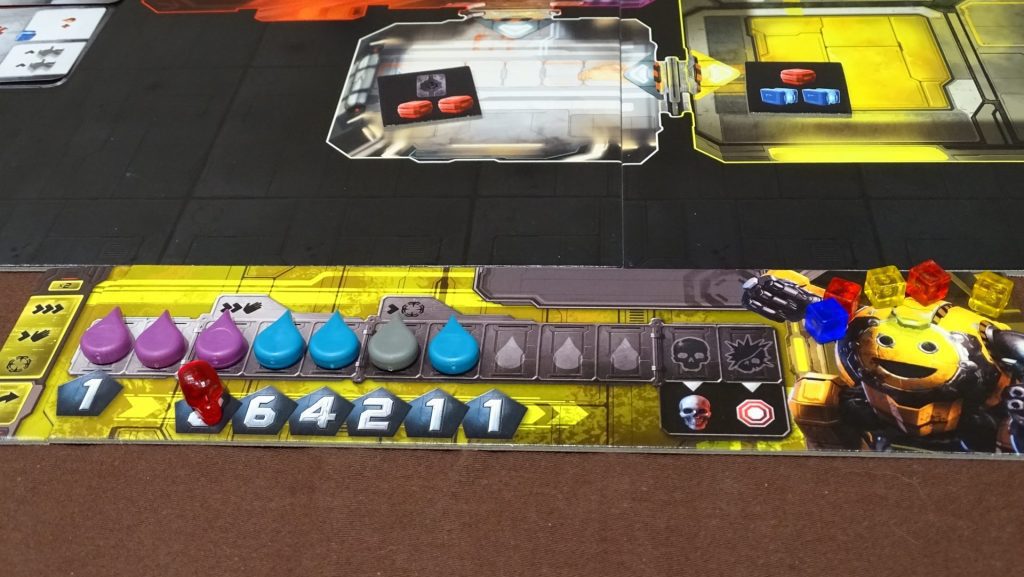
Adrenaline awards points based on equal opportunity mayhem. When a character dies the player that shot them the most gets the most points. The player that shot them the second most gets a little less, and so on. Bonus points are awarded to the player that drew first blood and killshot. You can also overkill an opponent, awarding you more points, but letting them mark you with their vengeance for being a jerk.
Adrenaline balances the chaos of a battle royale with the strategic requirements of a war room, yet also doesn’t want to be taken seriously. While other strategy games derive their fun from the challenge of mastering the game, Adrenaline’s fun comes from shooting your friends in the face.
This isn’t to say that Adrenaline is without strategy. Spraying bullets randomly only gets you so far. You’ll need to manage your ammo and plan your future turns carefully. You don’t want your turn to start without a weapon ready, forcing you to watch a perfect opportunity slip through your empty fingers.

Missed the Mark
No matter what the box says, Adrenaline plays best with 4 or 5 people. There is a Robot element you can add as a sort of proxy player, but it’s a poor replica. There are also variants available, but both feel a bit superfluous, like rules the designer wasn’t ready to let go.
Adrenaline suffers from a common ailment affecting many thematic Euros: attracting the audience it wants. The high strategy doesn’t mix well with the constant conflict, like a worker placement with simply not enough spaces. Too much player interaction will turn away many cube-pushing purists.
Meanwhile, thematic gamers are not going to get a high-octane real time shooter. There is no way to fully plan out your future turn due to the chaos of player movement, causing downtime as players are forced to read the situation only at the start of their turn. Nothing pops the fun balloon faster than waiting 10 minutes to shoot a gun.
But wait! There’s an expansion…
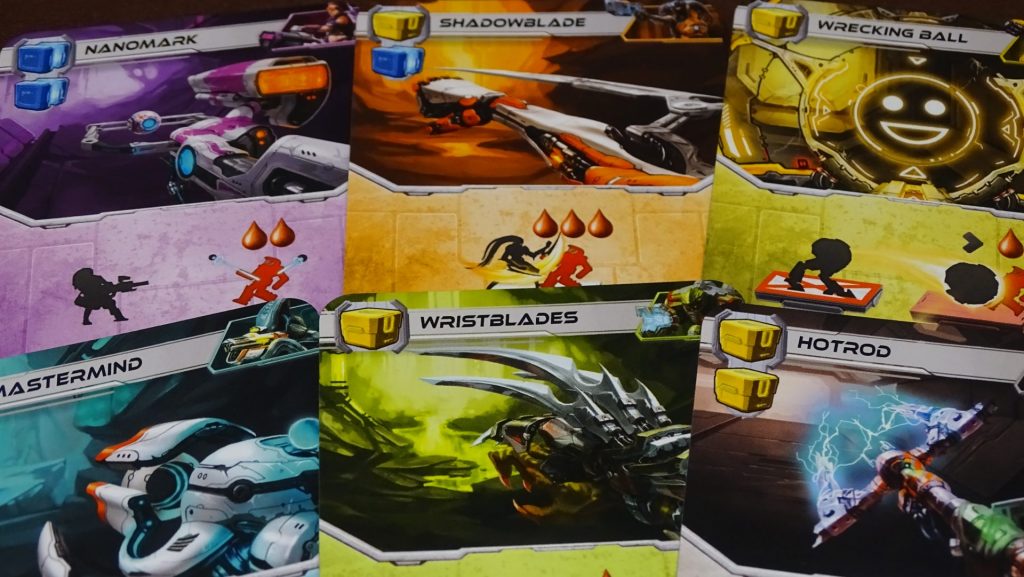
Adrenaline: Downloadable Content
The Team Play DLC expansion adds, obviously, a way to play Adrenaline in teams. It also adds unique player powers, a 6th player option, and a rules tweak to try and speed up play. Unfortunately there aren’t many new weapons added, and we are still lacking a cooperative experience.
The unique player powers are great for fleshing out the characters. They add a new element of individuality without taking away the balance. The lizard spits recurring acid, the soldier overloads his weapon for XTREME damage, and the robot goes in like a wrecking ball. More personality, more investment.
The team play is nice, but it makes player count weird. There are always six characters in team play, 3 per team, no matter the player count. And while I can’t imagine the length of play with six players, the new two player option works really well. A new delayed damage rule awards extra points based on how you spread damage and how many kills you can organize on one turn—changing up the efficiency puzzle for the better.

Since team play can seriously increase game length, a new rule was added for both game modes in order to speed up play. On your turn you can decrease your maximum health in order to gain the lost health bonuses mentioned earlier. This has the benefit of making players easier to kill while also allowing your turns to be more effective.
If you enjoy Adrenaline, the DLC content adds just enough to be relevant. It’s by no means a necessary expansion, unless you really want to play Adrenaline with two. The best improvement is the effect it has on game speed, allowing kills to happen faster and speed up an otherwise slow experience. If you can’t find a copy of the DLC, this rule can easily be proxied into your base game using a home-made token.
Final Thoughts
Adrenaline struggles to be the game it wants to be, not fully reaching its potential. Adrenaline has all the chaotic fun of killing your opponents with flashy weapons, mixed with the need for pensive strategic play. It wants your full attention, but adds too much downtime between turns, and works best with more people. Those three things don’t mix, and you should be able to see why Adrenaline often feels like it missed the mark.
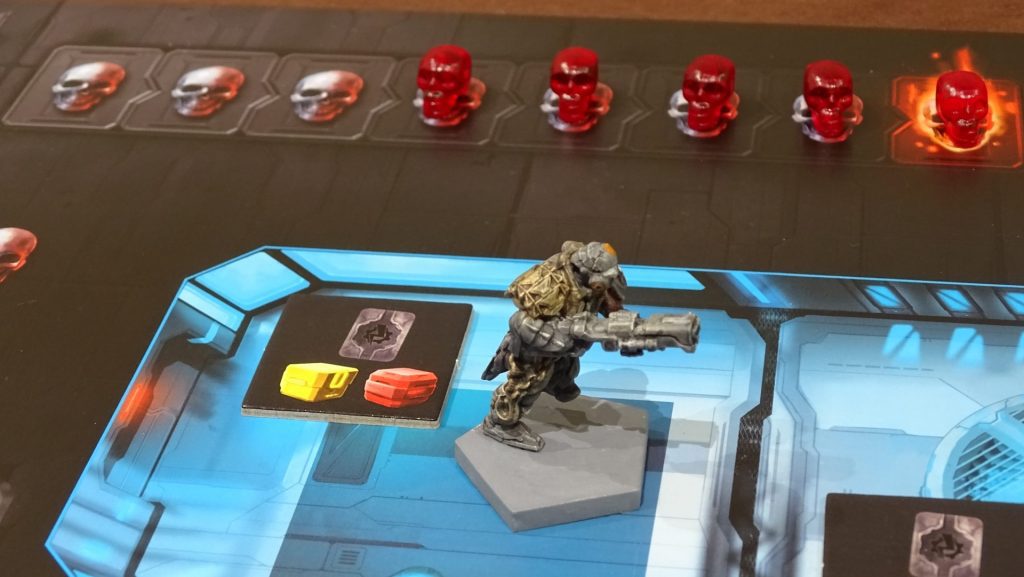
That said, I really enjoy this game when it hits the table. But it doesn’t hit often: Adrenaline needs the absolutely right group to reach its full potential, and that type of group will be rare, especially since it needs 4 or 5 players. For me, it means Adrenaline rarely saw play.
Luckily, the DLC breathed new life into the game for my table. The ability to play the game at 2 players removes a lot of downtime, mostly because there is less chaos. It is still slower than I’d like it to be, but the experience plays out better. The addition of delayed damage bonuses, the need to manage multiple shooters, the player powers: all of these micro-improvements give the game more color and help to keep the dust from gathering.
If you think your group is the target audience, grab Adrenaline and be prepared for a fun night of violence. I’ll be keeping it for the new 2-player option and the hopes we see a co-op expansion.
If you’re attending Essen Spiel 2019, be sure to check out Sanctum from the same team. Sanctum looks to be a similar homage-style game, but it flavors itself as a hack-and-slash style game akin to Diablo and Torchlight. It’s definitely at the top of my Essen list!
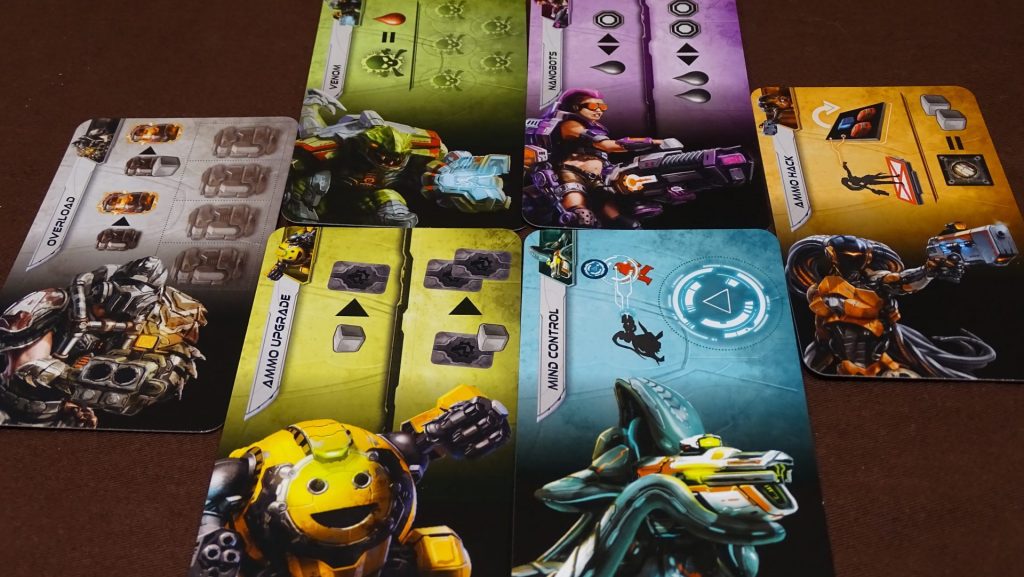











Add Comment